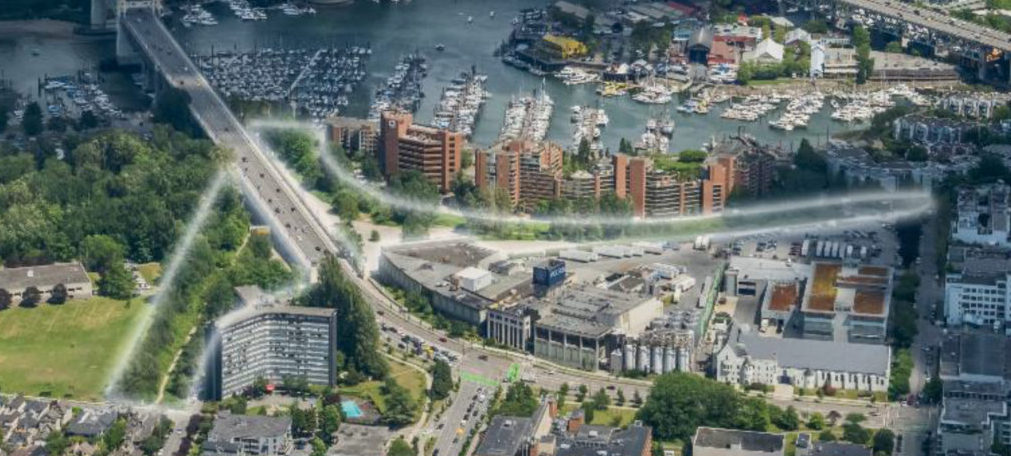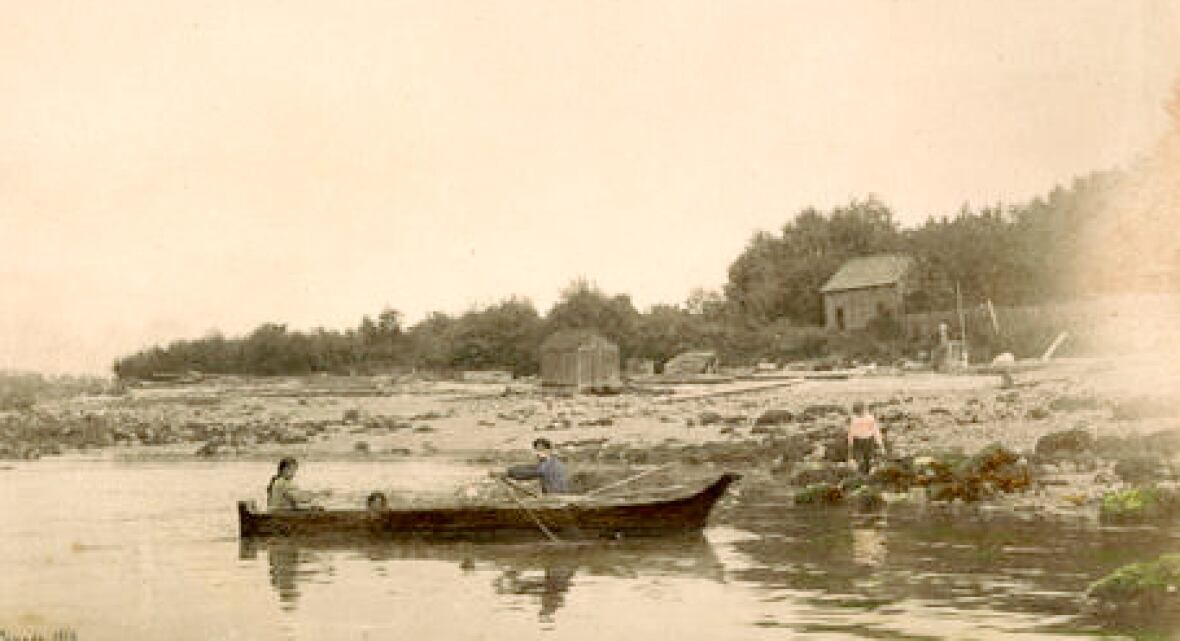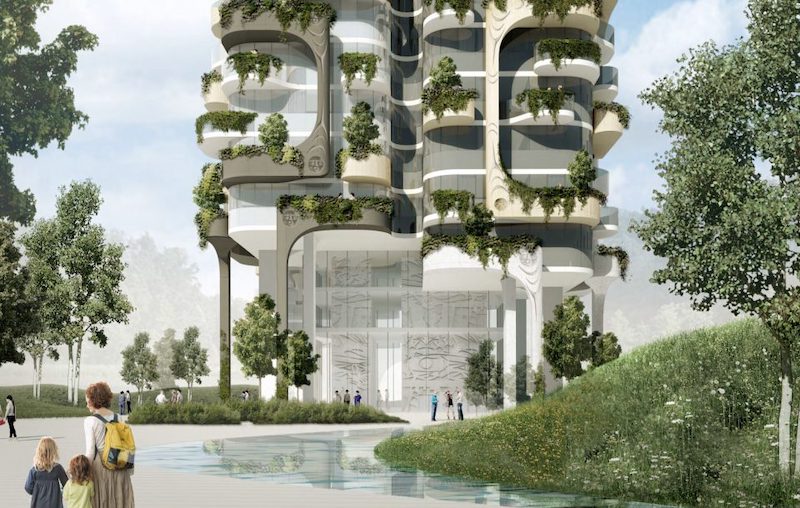On Dec. 10, the Squamish First Nation will vote on a development plan called Sen̓áḵw that could transform 11 acres of land near Vancouver’s downtown core from trees to high rises.
If the Squamish people vote yes, the economic value of that sliver of land could jump from zero to $600 million, overnight. That’s because they would be voting to give their elected band council the power to effectively rezone the parcel of land, which is reserve land.
Although the parcel of land sits within the City of Vancouver, it’s the nation that has full control over how to develop it. And what the Squamish want to do is build 6,000 units of mostly rental housing — quickly.
“We want to do something which is something the city has always wanted: a lot of rental at once,” said Khelsilem, a Squamish Nation councillor and spokesperson. “We are doing a major gift to the city to choose to do it this way.”
Not everyone is excited about the idea of building so much, so quickly on a relatively small site.
Ray Spaxman, a former chief planner for the City of Vancouver, is shocked that the Squamish have not divulged more details about the project to the wider community. He thinks 6,000 units is too much for this 11-acre site.
“It’s unprecedented in terms of the volume,” Spaxman said.
In advance of the Dec. 10 vote, here is everything we know so far about this game-changing development proposal.
What is the Squamish Nation proposing?
The nation is proposing to build a total of 6,000 new housing units in 11 towers on an 11.7-acre site. The tallest tower proposed is 56 storeys.
To put that in context, the tallest building in Vancouver is the Shangri-La at Georgia and Thurlow, at 62 storeys. Vancouver House, which towers over the north side of the Granville Bridge, is 59 storeys. The development as proposed would include 70 per cent rental and 30 per cent condos.
What is the Squamish Nation voting on?
The Squamish are voting on two questions: Are you willing to designate these lands for economic development? And, do you approve of moving forward with Westbank as the development partner?
If the Squamish vote yes on the first question, the land value will rise from $0 to $600 million, said Toby Baker, the CEO of Nch’kay Development Corporation, the Squamish Nation’s economic development company.
If they vote yes on the first question, but no to working with Westbank, the nation would likely move forward with the project, but look for another development partner, Baker said.
Why this site, and why now?
Sen̓áḵw is a small slice of what was once Kitsilano Indian Reserve No. 6, an 80-acre site. In 1913, the provincial government annexed the land and displaced the Squamish people who were living there to Howe Sound.
Over the years, other levels of government and private companies took more and more of that original parcel of land. In 2001, after a lengthy court battle, the Squamish were awarded a 10.5-acre site that is part of the Sen̓áḵw parcel.
Vancouver’s low rental vacancy rate is one factor that makes now a good time to plan a mostly rental project for the city, Khelsilem said. But, he added, there’s also “alignment” with the City of Vancouver, the province and federal government, who are all interested in funding more social and rental housing right now.
The Squamish Nation is highly motivated to develop a stable, long-term revenue source, Khelsilem said. From that point of view, it makes more sense to build rental.
“We can choose to do 5,000 condos and bring those condos online over 10 to 15 years to deal with the absorption of the amount of products we’re bringing online,” he said. “But we want to build rental and we want to build it quickly.”
How quickly? The nation estimates that after a design and public engagement process in 2020, construction will begin as early as 2021.
What about transportation and parks?
Khelsilem said the initial designs for the project are to build towers without the additional low-rise podiums for townhouses and retail that have been common for many Vancouver condo buildings.
That will leave 80 per cent of the land parcel available for parks and community space, including the opportunity to use the land under the bridge for things like basketball and lacrosse courts.

When it comes to transit, Khelsilem said the nation wants to work with partners like the city, the regional district, Canada Mortgage and Housing Corporation and other developers to re-activate the rail line that runs from Granville Island to Science World and was briefly in use during the 2010 Winter Olympics.
The project proponents will also need to work with TransLink and City of Vancouver engineering to put transit stops closer to the development and push to include more bus service for the area in TransLink’s next round of planning.
But it’s still unclear just how this project will fit into the existing transit strategy, said Andy Yan, an urban planner and director of Simon Fraser University’s City Program. School space and daycare are other factors that need to be considered, he added.
Is this a fair deal for the Squamish?
The Squamish chose the developer, Westbank, through a request-for-proposals process, Khelsilem said. The deal is structured on a 50/50 revenue-sharing format, and also means the partners jointly assume the debt to build the project, although Westbank is responsible for raising the $3 billion in construction financing. The 50/50 structure means that neither party can make decisions without the buy-in of the other.
It’s an unusual deal structure: Normally with reserve land, the federal government would ask the developer to pay a 99-year ground lease up-front, so all the money goes to the nation at the beginning of the lease term. But the 50/50 structure will yield more revenue to the Squamish over time, Khelsilem said.
That also means Westbank also stands to reap billions, a factor Khelsilem acknowledged can stir strong feelings as Vancouverites continue to struggle with an ongoing housing crisis. But, he said, the nation needs to partner with a developer experienced in building out large housing projects.
“We’re talking about something that a lot of people detest, which is developers profiting,” he said. “But in this situation, it’s a community and a government making money to support themselves.”
But the 50/50 structure will yield more revenue to the Squamish over time, Khelsilem said. The 50/50 split is fair, he said, because the Squamish are not putting any money into the deal. What the Squamish are contributing is land — and here’s where it gets complicated.
Because the land is federal reserve land, the federal government is technically the owner of the land, although it is supposed to benefit the Squamish people and cannot be seized by anyone, according to the Indian Act.
But that prohibition on land seizure makes it difficult to get bank financing to build houses and businesses on reserve land, Baker said, because normally banks lend with the understanding that they can take ownership of the land if the debtor does not pay.
To get around this limitation, Nch’kay plans to ask the federal government for a lease on the land. Then, the development partnership can go to banks or other financiers, using the lease (but not the land) as the collateral, Baker said.
Baker said the Canada Mortgage and Housing Corporation would likely be the first stop to look for financing because of the federal agency’s interest in financing rental housing under the federal government’s new National Housing Strategy.
How will the revenue be used?
When it comes to revenue for the Squamish Nation, Khelsilem said the nation will not only get revenue from rent and condo sales, but will have the power to tax property, just like a municipality (this is a relatively new power that First Nations governments can choose to exercise on reserve lands).
Taxation revenue from B.C.’s property transfer tax and any other provincial real estate taxes (the speculation tax and school tax, for instance) will also flow to the nation, Khelsilem said.
What the revenue will be used for is the biggest question coming from members of the Squamish Nation, Khelsilem said, and there’s no clear answer yet. “(It’s) an understandable question because we’re talking about $8 to $10 billion coming to the nation over the life of the project,” he said.
“What we’re committed to, and it’s been developed in our policy, is that the nation is going to start doing community consultations on the budget, similar to how municipalities and the provincial and federal governments do consultations.”
Why did the Squamish pick Westbank as the development partner?
Westbank is one of Vancouver’s biggest and most high-profile developers, but with that notoriety has come controversy. The company has been criticized for building developments that have stunning architecture, but units priced for the very wealthy, and for pre-selling many condo units overseas.
But Khelsilem said that through a request-for-proposal process that whittled nine proposals down to one, it became clear that Westbank was the best fit.
“Given their track record around environmental issues, their track record around social housing and rental, and Westbank’s... interest in creating unique architectural buildings in the city, those factors really impressed the nation and allowed Westbank to rise to the top,” Khelsilem said.

Khelsilem said the nation really wants the architecture to reflect Squamish culture: “They want these developments to shout to the world that these are Indigenous, these are Squamish,” he said.
The developers who submitted proposals also included proposals on unit mix: Some suggested 100 per cent rental, 100 per cent condos, and various mixes of the two. Khelsilem said the 70 per cent rental, 30 per cent condo breakdown presents the least financial risk for the Squamish Nation.
Will the Squamish make sure local buyers can purchase the condo units?
This has not yet been discussed by the project partners, Khelsilem said, but it could well be part of the negotiations between the two partners.
Another factor to consider is that the condos will be leasehold — that is, the buyers will not own their strata lot outright, but hold a leasehold interest for a specific term. Khelsilem said real estate developers have told the nation that there is much less interest in leasehold condos from foreign buyers.
Will any of the housing be affordable for people who work in Vancouver? Will Squamish members be able to live in any of the housing?
Those details are still to be worked out, but Khelsilem said it is the nation’s intention to provide affordable rental housing for Squamish Nation members. The nation has also been talking about providing an opportunity for Squamish members to buy condos, possibly at a discounted rate.
Is it too dense?
Spaxman said he has real concerns about the number of people the project would put in one small, awkwardly shaped land area.
“If you think of 6,000 units on 11 acres of land, you have quite a challenge,” he said.
“My preliminary information suggests it’s twice as much (density) as we’ve ever seen before, and that’s on a little squiggly piece of land.”
From the Squamish Nation’s perspective, Khelsilem said, the highest density possible is the ideal choice — because that’s how the nation will maximize its revenue from the project.
Building mostly rental also allows for more density, Khelsilem said, because while condo buyers expect their unit to come with an underground parking space, rental buildings can be constructed with much fewer parking spots. The project partners are planning to build so just 10 per cent of the rental units will have parking, which will reduce building costs.
“We didn’t propose a density level that’s completely arbitrary,” Khelsilem said. “It was based on an analysis of what is possible, given the constraints of the land and transportation.”
Will the City of Vancouver, or Vancouver residents, have any say?
After the vote on Dec. 10, the Squamish Nation does plan to roll out community engagement opportunities for the wider Vancouver community, Khelsilem said. But the Squamish Nation alone has the power to ultimately decide what to do with the land.
That being said, the nation can’t just go it alone on a piece of land that is also part of the City of Vancouver. The nation will have to work with the City of Vancouver, the Metro Vancouver Regional District and other partners to build out the infrastructure needed to service that many more people, Khelsilem said. (The nation already has signed a water and sewer agreement with Metro Vancouver for the site.)
It can take years to get approval from the City of Vancouver to rezone for much higher density. The fact that the Squamish can get a project like this off the ground quickly is a business advantage for developers and the nation, Khelsilem said.
“The lack of regulatory control and red tape represents a huge business opportunity, because it’s a significant savings in terms of time and resources allocated to a project,” he said. ![]()
Read more: Indigenous, Local Economy, Housing, Municipal Politics
















Tyee Commenting Guidelines
Comments that violate guidelines risk being deleted, and violations may result in a temporary or permanent user ban. Maintain the spirit of good conversation to stay in the discussion.
*Please note The Tyee is not a forum for spreading misinformation about COVID-19, denying its existence or minimizing its risk to public health.
Do:
Do not: